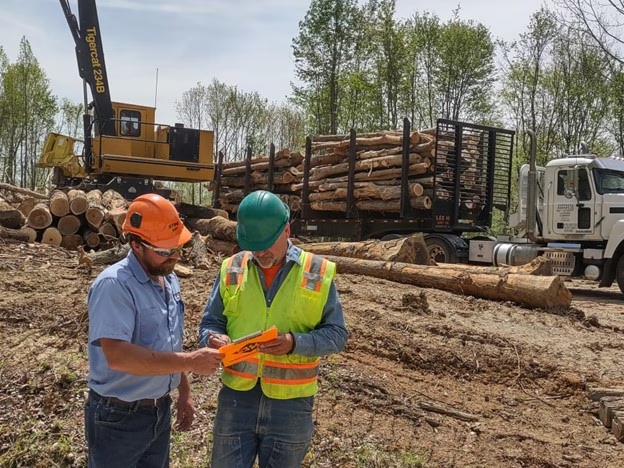Surprise OSHA Visit? Don’t Panic—Be Prepared

June is National Safety Month—a perfect time to revisit your workplace safety protocols and, more importantly, your readiness for an OSHA inspection. Whether it’s a scheduled visit or a surprise walk-through, being prepared can make all the difference. Safety is a shared responsibility, and both employers and employees play a vital role in maintaining a safe work environment.
As Tracie Gibbs, Director, Executive Operations and Safety, Rayonier, highlighted in last week’s Woods to Mill post, “Building a Stronger Workforce and Business by Making Safety a Core Value,” safety is a cornerstone of any successful operation. Employers have a responsibility to ensure that employees are trained in safety practices and recognize the value of following protocols and procedures. One such protocol is how to handle an OSHA inspection. Whether announced or unexpected, these visits can create confusion and stress if your team isn’t prepared. That’s why it’s critical for every employee to know what to expect and how to respond.
In my previous role as Safety Manager, overseeing multiple facilities, I found that preparedness was one of the most effective ways to reinforce the value of safety. When employees felt equipped to handle situations beyond their control—whether it was navigating unfamiliar tasks through pre-task conversations or responding to emergencies—they felt more confident and capable. One recurring concern among team members was how to handle an OSHA inspection, especially if it was unannounced or tied to a workplace incident. To provide clarity and reduce anxiety, my team and I developed a Standard Operating Procedure (SOP) that outlined exactly what to do during an OSHA visit. This simple step helped eliminate confusion and kept things running smoothly, even in high-stress moments.
The first and most important step is ensuring that the initial point of contact—often a receptionist, security guard, or front-line supervisor—knows exactly what to do when an OSHA inspector arrives. Proper training for all potential first points of contact is critical, as their response can influence the tone of the entire visit. That individual should either escort the inspector to a designated waiting area or politely ask them to wait in the lobby while notifying the appropriate site personnel. This simple action serves two key purposes: it maintains site security by preventing unescorted access and sets a professional, controlled tone for the inspection process.
Once the appropriate site personnel—ideally the site manager and safety supervisor—have been notified, the inspector should not proceed into the worksite until they have received a safety orientation and the necessary personal protective equipment (PPE). When meeting the inspector, staff should begin by collecting their contact information and clarifying the purpose and scope of the visit, including what triggered the inspection. Before proceeding further, provide a brief safety overview and required PPE. If the inspector requests documentation, such as employee training records, it’s best practice to request a written list of the specific documents before providing any copies. This helps ensure clarity and maintains a record of the interaction.
During my time as a Safety Manager, I learned that empowering employees to handle stressful situations through preparation and the right tools was key to strengthening our safety culture. Even when we faced serious incidents, that preparation enabled the team to respond effectively, caring for those involved and identifying root causes without panic. Trust and employee buy-in are the foundation of any strong safety program. When employers invest in training and readiness, they cultivate a more engaged workforce and a safer workplace overall.
Whether planned or unexpected, OSHA visits can be stressful, but preparation goes a long way. Training employees to respond professionally and equipping them with clear policies and procedures helps reduce uncertainty and builds confidence. By fostering a culture of readiness, organizations not only enhance internal teamwork but also establish a respectful and professional rapport with OSHA personnel, ultimately benefiting everyone in the long run. Remember: safety is a value, not a priority. Priorities shift—values don’t.
OSHA Inspection Response – Suggested Actions Checklist
Use this checklist to help ensure your team is prepared for both announced and unannounced OSHA inspections. You may also want to consult with your counsel about your rights and responsibilities during an OSHA inspection.
✅ Before an OSHA Visit
- Develop and communicate a Standard Operating Procedure (SOP) for OSHA inspections.
- Identify and train all potential initial points of contact (receptionist, security, supervisors).
- Assign designated inspection response personnel (site manager, safety supervisor).
- Ensure visitor orientation procedures and PPE requirements are current.
- Train all employees on appropriate OSHA interaction (what to say, what not to say).
- Maintain up-to-date safety documentation and employee training records.
✅ Upon Inspector Arrival
- Initial contact greets the inspector professionally.
- Escort the inspector to a designated waiting area or lobby.
- Notify designated site personnel immediately (manager, safety supervisor).
- Do not allow unescorted access to any part of the facility.
✅ Initial Meeting with OSHA
- Collect inspector’s name, contact info, and credentials.
- Clarify purpose, scope, and trigger for the inspection.
- Provide safety orientation and required PPE.
- Request written list of any documentation requested.
✅ During the Walkthrough
- Escort the inspector only to relevant areas tied to the inspection.
- Ensure conversations with employees (if any) occur privately.
- Designated personnel should accompany the inspector at all times.
- Take identical photos of anything the inspector photographs.
- Respond to questions factually; do not speculate.
- Say “I don’t know” rather than guess.
✅ After the Inspection
- Debrief with internal team.
- Document what was reviewed and any materials provided.
- Follow up on any findings or corrective actions, if applicable.
- Maintain a professional record of the inspection for internal use.

